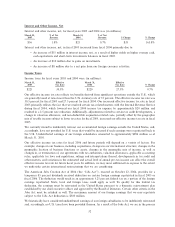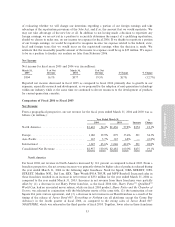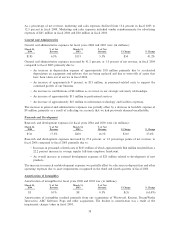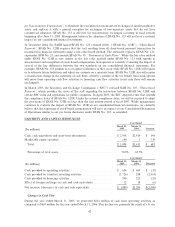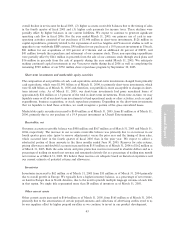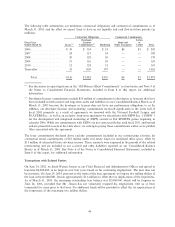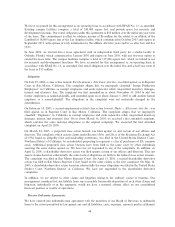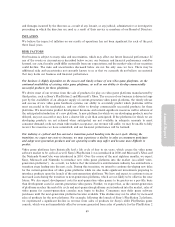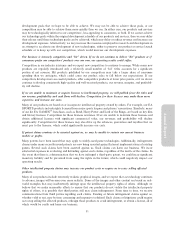Electronic Arts 2005 Annual Report Download - page 97
Download and view the complete annual report
Please find page 97 of the 2005 Electronic Arts annual report below. You can navigate through the pages in the report by either clicking on the pages listed below, or by using the keyword search tool below to find specific information within the annual report.
Income Taxes
Income taxes for Ñscal years 2004 and 2003 were (in millions):
March 31, EÅective March 31, EÅective
2004 Tax Rate 2003 Tax Rate % Change
$220 27.5% $143 31.0% 53.3%
Our eÅective income tax rate reÖected tax beneÑts derived from signiÑcant operations outside the U.S., which
are generally taxed at rates lower than the U.S. statutory rate of 35 percent. The eÅective income tax rate was
27.5 percent for Ñscal 2004 and 31.0 percent for Ñscal 2003. The reduced eÅective income tax rate in Ñscal
2004 primarily reÖected the resolution of certain tax-related matters with the Internal Revenue Service in the
fourth quarter of Ñscal 2004, which lowered our income tax expense by $20 million and resulted in a
2.5 percent rate reduction, and also reÖected a change in the geographic mix of taxable income subject to
lower tax rates.
Net Income
Net income for Ñscal years 2004 and 2003 was (in millions):
March 31, % of Net March 31, % of Net
2004 Revenue 2003 Revenue $ Change % Change
$577 19.5% $317 12.8% $260 82.1%
Reported net income increased in Ñscal 2004 compared to Ñscal 2003 primarily due to the reasons discussed
above. Although the dollar amount of our expenses increased in Ñscal 2004 as compared to Ñscal 2003, net
income as a percentage of net revenue increased to 19.5 percent as compared to 12.8 percent in Ñscal 2003 as
expenses, including our cost of goods sold, grew at a slower rate than did our net revenue.
Impact of Recently Issued Accounting Standards
In March 2004, the Financial Accounting Standards Board (""FASB'') ratiÑed the other-than-temporary
impairment measurement and recognition guidance and certain disclosure requirements for impaired securi-
ties as described in EITF Issue No. 03-1, ""The Meaning of Other-Than-Temporary Impairment and Its
Application to Certain Investments''. In September 2004, the FASB issued a proposed StaÅ Position (""FSP'')
EITF Issue No. 03-1-a, ""Implementation Guidance for the Application of Paragraph 16 of EITF 03-1''. The
proposed FSP will provide measurement and recognition guidance with respect to debt securities that are
impaired solely due to interest rates and/or sector spreads. In October 2004, the FASB delayed the eÅective
date for the other-than-temporary impairment measurement and recognition guidance contained in
Annual Report
paragraphs 10-20 of EITF Issue No. 03-1 until FSP Issue No. 03-1-a is issued. However, this delay does not
suspend the requirement to recognize other-than-temporary impairments as required by existing authoritative
literature; nor does it delay the required disclosures about unrealized losses that have not been recognized as
other-than-temporary impairments in paragraphs 21-22 of EITF Issue No. 03-1. See Note 2 of the Notes to
Consolidated Financial Statements. Management is unable to determine what impact the adoption of the
measurement and recognition guidance in EITF Issue No. 03-1 will have on our consolidated Ñnancial
statements.
In November 2004, the FASB issued SFAS No. 151, ""Inventory Costs Ì an amendment of ARB No. 43,
Chapter 4''. SFAS No. 151 amends the guidance in Accounting Research Bulletin (""ARB'') No. 43,
Chapter 4, ""Inventory Pricing'', to clarify the accounting for abnormal amounts of idle facility expense, freight,
handling costs, and wasted material (spoilage) and requires that those items be recognized as current-period
charges. SFAS No. 151 also requires that allocation of Ñxed production overheads to the costs of conversion
be based on the normal capacity of the production facilities. SFAS No. 151 is eÅective for inventory costs
incurred during Ñscal years beginning after June 15, 2005. Management believes the adoption of
SFAS No. 151 will not have a material impact on our consolidated Ñnancial statements.
In December 2004, the FASB issued SFAS No. 153, ""Exchange of Non-monetary Assets Ì an amendment
of APB Opinion No. 29''. SFAS No. 153 amends Accounting Principles Board (""APB'') No. 29, ""Accounting
41



